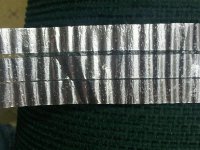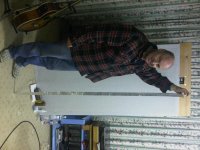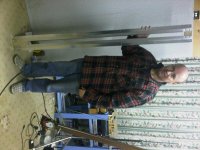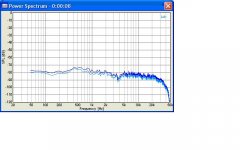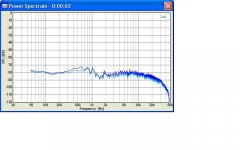depends on the implementation and driver
So you don't go to live concerts that use bass bins with drivers mounted in boxes??
again, the room is essentially one big box... and most rooms have dominant modes which characterize the sound to a much greater extent below the Schroeder frequency...
The "box" used for my 6.5" woofers is vented rearward, and really isn't much different than a constrained "H" frame woofer setup, as the "Q" is rather low (maybe too low)
My setup includes 4 sonotube subs from 80 Hz down distributed optimally throughout the room and overcomes much of this modal dominance, through careful placement by providing additional sources. I've done this for 15 years or so, and Harmon Kardon and Geddes have popularized this approach recently
Your disparaging remarks sound like an over-generalization...
John L.
I'm using H-baffles. I dont like boxes either! Once you get used to how dipoles sound, you never ever want that hollow "boxy" restrained nondynamic muffled resonant box sound ever again.

So you don't go to live concerts that use bass bins with drivers mounted in boxes??
again, the room is essentially one big box... and most rooms have dominant modes which characterize the sound to a much greater extent below the Schroeder frequency...
The "box" used for my 6.5" woofers is vented rearward, and really isn't much different than a constrained "H" frame woofer setup, as the "Q" is rather low (maybe too low)
My setup includes 4 sonotube subs from 80 Hz down distributed optimally throughout the room and overcomes much of this modal dominance, through careful placement by providing additional sources. I've done this for 15 years or so, and Harmon Kardon and Geddes have popularized this approach recently
Your disparaging remarks sound like an over-generalization...
John L.
In theory - dipoles don't "drive" the standing waves within the room at all, because they are not pressure sources. In reality they do to some degree, but far less than monopoles ("boxes"). That's both measureable and very audible. This is one of the reasons many people praise dipole bass. 
I do occationally go to amplified concerts yes, but not to enjoy great sound...... Its like going to McDonalds, you just dont go there if you expect something that tastes good or is good for you.
I do occationally go to amplified concerts yes, but not to enjoy great sound...... Its like going to McDonalds, you just dont go there if you expect something that tastes good or is good for you.
Quality of bass
Yes...Linkwitz's site has alot of info re: dipole radiation, bass quality, etc. and such...
My setup has often been accused of being "lite" on bass compared to other setups... until one hears well recorded slap bass, for example, or deep organ tones welling up in a cathedral (more felt in an enveloping sense than heard)... not to mention home theater soundtracks with lots of subterranean information (explosions, choppers, truck noise in cities) plus some directors seem able to extract more realistic sound from music than one typically hears on cd's, records, etc.
None of that bloated thump-mobile one note hyper resonant crap...
John L.
In theory - dipoles don't "drive" the standing waves within the room at all, because they are not pressure sources. In reality they do to some degree, but far less than monopoles ("boxes"). That's both measureable and very audible. This is one of the reasons many people praise dipole bass.
I do occationally go to amplified concerts yes, but not to enjoy great sound...... Its like going to McDonalds, you just dont go there if you expect something that tastes good or is good for you.
Yes...Linkwitz's site has alot of info re: dipole radiation, bass quality, etc. and such...
My setup has often been accused of being "lite" on bass compared to other setups... until one hears well recorded slap bass, for example, or deep organ tones welling up in a cathedral (more felt in an enveloping sense than heard)... not to mention home theater soundtracks with lots of subterranean information (explosions, choppers, truck noise in cities) plus some directors seem able to extract more realistic sound from music than one typically hears on cd's, records, etc.
None of that bloated thump-mobile one note hyper resonant crap...
John L.
Hi John,
I have absolutely no doubt your system is much, much better than 90% of what's out there, at any price. Still, I don't think any bass can compare to an array of H baffle, it just give as realistic a bass as it can get.
Closed boxes come second and do have an edge on impact, yes, but you will never get that "airy" feeling, especially on real instruments, like double bass, piano, or drums. On top of that, the IR is better, and the directivity is controlled, not all over the place like other concepts, but you know all that too well I am sure!
I don't think movies artifacts qualify for bass test. Regarding deepest organ notes, it is indeed difficult to reproduce them loud with a dipole, (if at all!)you need to stack many subs like Stig Erik did. I am sure deep in his dreams, he would like even more of them! It does sound like a waste of space and money, but this is what it takes, unfortunately.
It does sound like a waste of space and money, but this is what it takes, unfortunately.
Don't get me wrong, I am also keen to give sonotubes a try this summer, and if I had the space, an infinite baffle..
To be honest, I have yet to find a dipole owner turn back to "traditional" boxes..
Edit: you mentionned Geddes, he does manage to flatten the response and control some modes with several subs strategically placed, yes, but how does the impulse response looks like?
Cheers
Laurent
I have absolutely no doubt your system is much, much better than 90% of what's out there, at any price. Still, I don't think any bass can compare to an array of H baffle, it just give as realistic a bass as it can get.
Closed boxes come second and do have an edge on impact, yes, but you will never get that "airy" feeling, especially on real instruments, like double bass, piano, or drums. On top of that, the IR is better, and the directivity is controlled, not all over the place like other concepts, but you know all that too well I am sure!
I don't think movies artifacts qualify for bass test. Regarding deepest organ notes, it is indeed difficult to reproduce them loud with a dipole, (if at all!)you need to stack many subs like Stig Erik did. I am sure deep in his dreams, he would like even more of them!
Don't get me wrong, I am also keen to give sonotubes a try this summer, and if I had the space, an infinite baffle..
To be honest, I have yet to find a dipole owner turn back to "traditional" boxes..
Edit: you mentionned Geddes, he does manage to flatten the response and control some modes with several subs strategically placed, yes, but how does the impulse response looks like?
Cheers
Laurent
Yes...Linkwitz's site has alot of info re: dipole radiation, bass quality, etc. and such...
My setup has often been accused of being "lite" on bass compared to other setups... until one hears well recorded slap bass, for example, or deep organ tones welling up in a cathedral (more felt in an enveloping sense than heard)... not to mention home theater soundtracks with lots of subterranean information (explosions, choppers, truck noise in cities) plus some directors seem able to extract more realistic sound from music than one typically hears on cd's, records, etc.
None of that bloated thump-mobile one note hyper resonant crap...
John L.
Last edited:
StigErik - this is a story of my two audio friends Steve and Chris. They both had magneplanar tympanies, like me, albeit they had original maggie tweeters and knew that my RD75 was superior to the original tweeter. Steve also had a pair of Trevor Lees ribbons (trevor is a local Melbourne audio manufacturer) which were made especially for Tympanies. Only problem with them is a low 2 ohm impedance which didn't go too well with Steve's AR valve amp.Yeah, please post pics and some info about the ribbon tweeter. I'm very interested, since to be honest, RD-75 is the best tweeter I've heard.... and if anything potentially better is out there ...?
So they decided 2 build their own 65 inch ribbons to match the height of the Maggie bass panels. They managed to do this, the clever boys and the resulting ribbons sound absolutely brilliant - they kill my RD75. So I need to build a pair as well. But I have gone a low cost route - Steve has sold me his old Trevor Lees ribbons and I am now pulling them apart and re-building with a new improved 4 om ribbon.
So my ribbons are not yet complete but I can say that the ones made by Steve and Chris sound brilliant. Chris uses the same 50 watt class A mosfet amps that I do, in bi-amp mode, so I am able to make very good comparison. While the RD75 is very good (excellent) in all regards, these ribbons are better in every way and I have not found a weakness. They have incredible speed and air, and while I have not measured the response I am sure that it does have a more extended HF than the RD75. A great project for anyone. I can get details magnets etc if anyone wants.
Airfoil Shaped Baffles for RD75
I hope that I am not being disruptive by posting here. I've just come across this thread. Early on there was a reference to 'airfoil shaped' baffles and their benefits. I have a pair that was cut on a CNC that have served me very well. Their shape was defined by the work that Rudi Blondia and John Whittaker did in the study sited previously. I used them for years and only recently pulled them out of service to experiment with other loudspeakers. In any case here they are. The last PIC does the best job of showing the airfoil shape.




I crossed them over to stock JBL Cinema cabs at 240Hz. They sounded great! My only complaint was that they got 'beamy' from 8kHz up. I was always gonna add some kind of tweeter array to the front of the baffle to fix that but never got around to it.
I highly recommend airfoil shaped baffles for these drivers!
I hope that I am not being disruptive by posting here. I've just come across this thread. Early on there was a reference to 'airfoil shaped' baffles and their benefits. I have a pair that was cut on a CNC that have served me very well. Their shape was defined by the work that Rudi Blondia and John Whittaker did in the study sited previously. I used them for years and only recently pulled them out of service to experiment with other loudspeakers. In any case here they are. The last PIC does the best job of showing the airfoil shape.




I crossed them over to stock JBL Cinema cabs at 240Hz. They sounded great! My only complaint was that they got 'beamy' from 8kHz up. I was always gonna add some kind of tweeter array to the front of the baffle to fix that but never got around to it.
I highly recommend airfoil shaped baffles for these drivers!
Last edited:
Yes, please share.
Measurements would be very nice to see. Is it possible for you to provide any?
The reason I ask, is that I've seen a few DIY ribbons, and they all measured badly. One pair was -15 dB at 20 kHz...
Try this - Chris not sure but thinks he used software called WinMLS, and a panasonic microphone. Very flat up to 20kHz then a roll-off after that. Not sure if the roll-off is a function of the software, or a function of my power amp design (output stage is a mosfet in common source configuration, it will suffer higher input capacitance than a source follower which is more common, but I've never actually measured the response of the amp).
Attachments
Carl, very interesting - do you know the reasoning to have ab aerofoil on one side, and no baffle on the other?
Yea, that came out of the Blondia & Whittaker study that was sited earlier. The airfoil shaped baffle that was published in AudioXpress magazine had the same feature. Altho I lived in the midwest at the time, I was in close communications with Rudi and John as they did their gymnasium experiments that are documented in their paper. I tried several baffle types (some are documented on that website). The airfoil baffle that I currently have is head and shoulders above everything else that I tried. The 'baffle missing on one side' definitively has an affect on soundstage, it improves it!
I just went looking for plots of the measurements that I took when I had the RD75s in service. I no longer seem to have them. I used the active crossovers in a Datasat AP20 at the time. The EQ that I used was Dirac Live that ran as part of the AP20. What I remember is that after extensive listening tests the RD75s sounded best when crossed aggressively at 240Hz. A knowledgeable person who uses this technology in a commercial product suggested that I try a lesser aggressive rolloff at 330Hz. I never got around to trying that.
I remember that the resonant peak in my RD75s were not at the same frequency. One was about a kilohertz higher than the other suggesting that the diaphragm was stretched tighter on that one.
That same knowledgeable person told me that their product has multiple diaphragm elements that radiate the high frequencies. That was how they got around the 'beamy' quality that I had described. He seemed confident that my tweeter array idea fixed to the front baffle and crossed between 6.5kHz to 8kHz would work just as well.
I remember after EQ the RD75s were quite flat out to 8kHz where they started rolling off. Without EQ they were well down by 12kHz and gone by 15kHz. I use a calibrated Earthworks M30 to take all of my measurements.
What I do remember about the RD75s was how wonderful they could sound when properly EQ'd. I am tempted to drag them out of that spare bedroom where they are stored and press them back into service!
Hm..... my RD-75's are essentially flat from 200 to 15 kHz (apart from the response peak at 5.5 kHz), and approx 8 dB down at 20 kHz. I have not baffle at all, just some foam tubing at the edges to reduce diffraction.
By 'down at 12kHz' I meant down 3dB and 6dB by 15kHz, not too much different than what you describe. Perhaps the 'one side baffle' and the 15 year age of my drivers plays into this as well. In any case I was very happy with them. My only annoyance was the 'beaminess' that I described.
... Could there the a difference between new and older RD-75's ?
That could be! Stranger things have happened. Maybe I should inquire as to it would cost to have mine rebuilt. BG in Carson City is about a 5 hour drive from Bakersfield.
- Status
- This old topic is closed. If you want to reopen this topic, contact a moderator using the "Report Post" button.
- Home
- Loudspeakers
- Planars & Exotics
- B&G RD-75 dipole - baffle and or waveguide?
